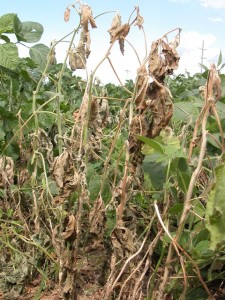
Wilting and plant death as a result of Sclerotinia stem rot. Photo Credit: Craig Grau.
Damon Smith, Extension Field Crops Pathologist, University of Wisconsin
Kiersten Wise, Extension Specialist for Field Crop Diseases, Purdue University
Martin Chilvers, Extension Field Crops Pathologist, Michigan State University
Carl Bradley, Extension Plant Pathologist, University of Illinois
Daren Mueller, Extension Plant Pathologist, Iowa State University
Farmers in the Great Lakes area of the U.S. may be concerned about white mold (also called Sclerotinia stem rot) in soybean this year. The disease, caused by the fungus Sclerotinia sclerotiorum, is not common every year in in the Great Lakes region, but farmers that have battled the disease in the past will want to assess the risk of white mold development as soybeans approach flowering (growth stage R1 – plants have at least one open flower at any node).
White mold development is favored by cool, cloudy, wet, humid weather at flowering. The disease is more problematic in soybeans in high-yield environments where high plant populations, narrow row spacing, and an early-closing canopy are commonly used. No single management strategy is 100% effective at eliminating white mold, and in-season options for at-risk fields are limited. For more information on white mold, the disease cycle, and additional management options click here and scroll down to “White Mold.”
There are fungicides available for in-season management of white mold, however not all commonly used fungicides are labeled for use against white mold in soybean. For information on which fungicides are labeled for disease control and recommendations on fungicide efficacy, please click here. Fungicide recommendations are developed by the NCERA-137 national soybean disease committee, and recommendations are based on replicated research data collected from University trials.
In Wisconsin in 2013 numerous products were evaluated for white mold control in soybean. Results of this trial can be viewed by clicking here and scrolling down to pages 6 and 7. Consistent with results of the NCERA-137 research, our Wisconsin research identified several products having a rating of ‘good’ for white mold management, including Aproach, Endura, and Proline. If using fungicides for white mold management, keep in mind that efficacy may be based on the ability of the fungicide to penetrate into the canopy, and the timing of the fungicide application. Fungicides will be most effective at reducing the impact of white mold when applied at, or close to, growth stage R1. Wisconsin research data indicates that fungicides applied up to growth stage R3 (early pod – pods are 3/16-inch long at one of the four uppermost nodes) may be effective, but later applications will likely not be effective at reducing disease. Once symptoms of white mold are evident, fungicides will have no effect on reducing the disease. Fungicide applications for white mold management may be most useful on fields where varieties rated as susceptible to white mold are planted in a field with a history of the disease.
If a soybean field is diagnosed with high levels of white mold, this field should be harvested last. This will help reduce the movement of the survival structures of the white mold fungus by harvesting equipment, to fields that are not infested. Also, be sure to clean all harvesting equipment thoroughly at the end of the season to avoid inadvertent infestation of fields. Rotations of 2-3 years between soybean crops can help reduce the level of the fungus causing white mold in fields. Using corn or small grains crops such as wheat, barley, or oats in rotation with soybean is recommended.
There are several resources available to help farmers and agribusiness personnel manage white mold. Extension plant pathologists across the North Central Region have developed a useful resource in collaboration with the North Central Soybean Research Program to describe the disease and optimal management strategies. This resource, along with downloadable fact sheets, can be found here.
This group also developed a podcast series to facilitate learning about white mold on-the-go. This series can be accessed by clicking here.
There is also a University of Wisconsin Cooperative Extension video that shows symptoms of white mold and discusses management options for the disease. The video can be found on YouTube by clicking here.














